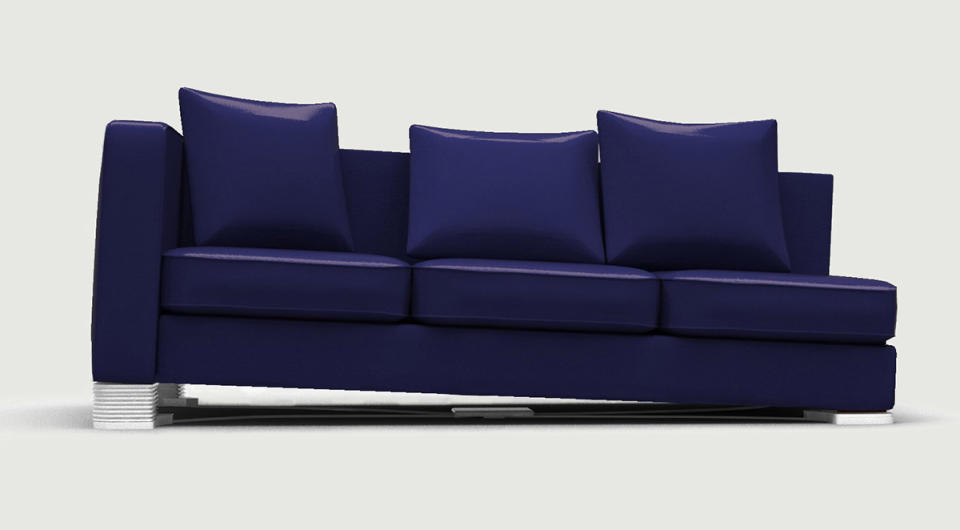You'll soon be able to turn your sofa into a 4D theme park ride
Buzz Lightyear is tearing around on his jetpack in Toy Story 2, but I'm not watching passively. Every time he banks left, my chair banks left. When he accelerates and climbs, I tilt back. When he finally touches down on a strange planet, my seat drops with a bump. No, I'm not at a theme park or "4D"-equipped theater -- I'm sitting on a couch. Specifically, I'm at the Paris headquarters of Immersit, a company that wants to turn your trusty sofa into an honest-to-Dieu ride simulator. I got to take a spin on its latest prototype, and spoiler: It was pretty cool. But would anybody be willing to pay the price of a decent laptop to get 4D at home?
Company CEO Valentin Fage certainly hopes so, and told me that there's nobody out there trying to sell affordable motion sims. "We wanted to build a product that appeals to a wide variety of users ... families who want to watch Disney movies with their kids, cinema lovers and gamers who want an enhanced experience."

Immersit CEO Valentin Fage
Conceptually, Immersit's product is similar to theater systems like the 4DX. The third-generation prototype (arriving in August) consists of four pneumatic, air-pump activated "feet" that sit under the legs or corners of your sofa or love seat. They're capable of moving independently up to 10cm (four inches), creating pitch (back and forth), roll (side to side) and heave (up and down) motion, along with vibration. The final system will support up to 500 kilograms (1,100 pounds), easily handling the weight of a couch with four people seated.
A central control module receives "motion code" commands from a laptop or tablet via WiFi to operate the feet in sync with a movie or game, either actively or passively. As with a 4DX-style ride sim, motion-control artists must pre-program any Blu-ray or DVD movie for it to actively sync up with Immersit. For my demo, the company had pre-encoded action sequences from Jurassic Park and Toy Story 2, making the couch move in time with the action. If a movie isn't actively encoded, Immersit can still move your chair passively by matching movement with the audio soundtrack.

As for games, it's simple. The system is synced up with your controller, so that when you turn or move forward in, say, a driving game, your chair will pitch and bank to match. If the controller vibrates, the chair will buzz. I tried it with an Xbox 360 F1 game, and the couch pitched back and forth during acceleration and braking, while banking along with turns.
So how was it? Surprisingly good. I know that 4D theaters are gimmicky as hell, but I've always loved ride sims like the Back to the Future and Simpsons 3D rides at Universal's theme park. You can dial up Immersit's travel and speed, or turn it down for a milder experience. The maximum amount of motion during the roller-coaster ride, Buzz Lightyear sequence and gaming demos was too weak for my taste. But Fage told me that the next prototype would not only respond more quickly than the second-generation version, but also have a greater range of travel as well. (Hopefully it won't be so powerful that it'll break your couch, which is definitely not designed for that.) In addition, it will supposedly operate silently, unlike the prototype I tried.

I did enjoy the movie sequences with 4D motion enhancement, but the quality of the active programming varied. It was best during swooping chase or flying scenes with lots of banking, turning and acceleration. At other times, the experience was uneven and occasionally distracting. However, Fage again assured me that the programming would improve before it goes on sale.
I liked Immersit for gaming. If you're playing a driving game like Forza Horizon or F1, why not make it more dynamic? It made me want to try it in flying sims, FPS games and anything else where more immersion is better. Marry it with an Oculus-type virtual reality (VR) device? Why not! Full VR realism combined with dynamic motion sounds like a natural match, assuming motion sickness isn't an issue.

Immersit will launch its 4D motion sim to the public on Kickstarter in September. So far, the company hasn't locked down the price, but Fage figures it'll be the same as a good laptop, around $800 to $1,200. A home theater or VR buff with means probably wouldn't think twice about dropping such a sum on their setup. But what if you're not rich?
Immersit has the most potential for gaming, but that's a heck of a lot of money for a gaming accessory. On the plus side, there's no other product that can do what it does for anything close to that amount. But will enough people want one to make it a success? That's certainly very debatable. I doubt that there are tons of people who are crazy about 4D, so a lot will depend on the price and how well the final product works. We'll get a lot better idea about that when the third-generation prototype is unveiled next month.
